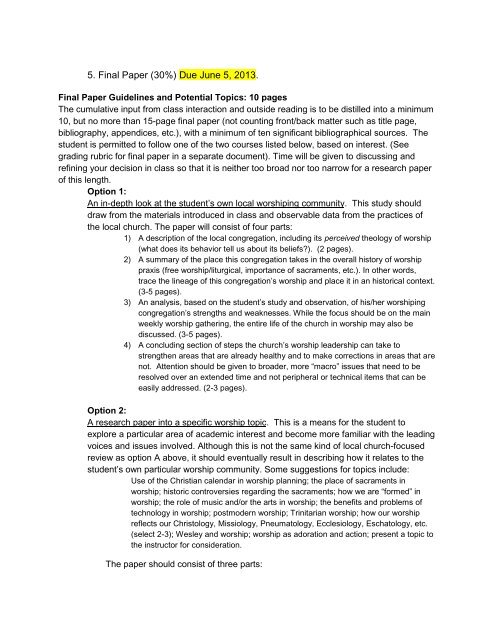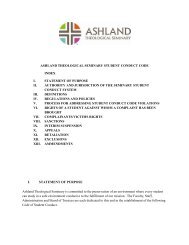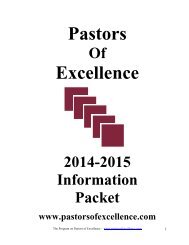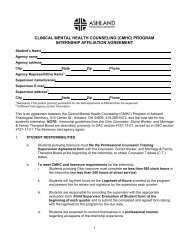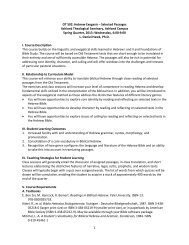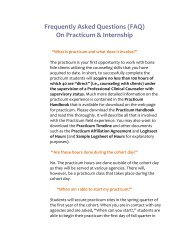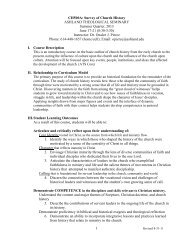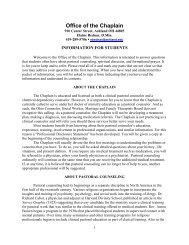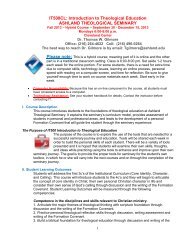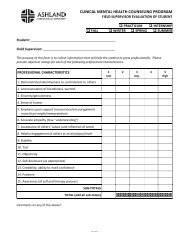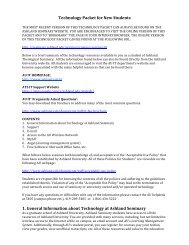PM 512 INTRODUCTION TO CHRISTIAN WORSHIP ASHLAND ...
PM 512 INTRODUCTION TO CHRISTIAN WORSHIP ASHLAND ...
PM 512 INTRODUCTION TO CHRISTIAN WORSHIP ASHLAND ...
Create successful ePaper yourself
Turn your PDF publications into a flip-book with our unique Google optimized e-Paper software.
5. Final Paper (30%) Due June 5, 2013.<br />
Final Paper Guidelines and Potential Topics: 10 pages<br />
The cumulative input from class interaction and outside reading is to be distilled into a minimum<br />
10, but no more than 15-page final paper (not counting front/back matter such as title page,<br />
bibliography, appendices, etc.), with a minimum of ten significant bibliographical sources. The<br />
student is permitted to follow one of the two courses listed below, based on interest. (See<br />
grading rubric for final paper in a separate document). Time will be given to discussing and<br />
refining your decision in class so that it is neither too broad nor too narrow for a research paper<br />
of this length.<br />
Option 1:<br />
An in-depth look at the student’s own local worshiping community. This study should<br />
draw from the materials introduced in class and observable data from the practices of<br />
the local church. The paper will consist of four parts:<br />
1) A description of the local congregation, including its perceived theology of worship<br />
(what does its behavior tell us about its beliefs). (2 pages).<br />
2) A summary of the place this congregation takes in the overall history of worship<br />
praxis (free worship/liturgical, importance of sacraments, etc.). In other words,<br />
trace the lineage of this congregation’s worship and place it in an historical context.<br />
(3-5 pages).<br />
3) An analysis, based on the student’s study and observation, of his/her worshiping<br />
congregation’s strengths and weaknesses. While the focus should be on the main<br />
weekly worship gathering, the entire life of the church in worship may also be<br />
discussed. (3-5 pages).<br />
4) A concluding section of steps the church’s worship leadership can take to<br />
strengthen areas that are already healthy and to make corrections in areas that are<br />
not. Attention should be given to broader, more “macro” issues that need to be<br />
resolved over an extended time and not peripheral or technical items that can be<br />
easily addressed. (2-3 pages).<br />
Option 2:<br />
A research paper into a specific worship topic. This is a means for the student to<br />
explore a particular area of academic interest and become more familiar with the leading<br />
voices and issues involved. Although this is not the same kind of local church-focused<br />
review as option A above, it should eventually result in describing how it relates to the<br />
student’s own particular worship community. Some suggestions for topics include:<br />
Use of the Christian calendar in worship planning; the place of sacraments in<br />
worship; historic controversies regarding the sacraments; how we are “formed” in<br />
worship; the role of music and/or the arts in worship; the benefits and problems of<br />
technology in worship; postmodern worship; Trinitarian worship; how our worship<br />
reflects our Christology, Missiology, Pneumatology, Ecclesiology, Eschatology, etc.<br />
(select 2-3); Wesley and worship; worship as adoration and action; present a topic to<br />
the instructor for consideration.<br />
The paper should consist of three parts:


